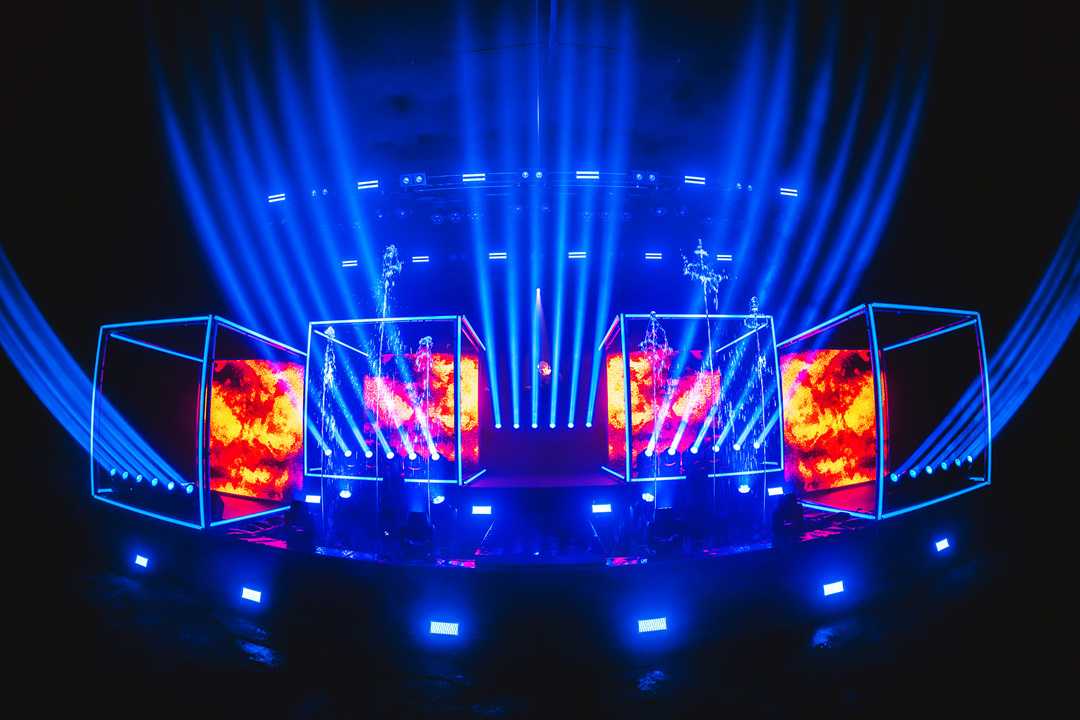ADJ brings festival-style production to livestreams
- Details

The Wharf is the latest in a series of three increasingly ambitious dedicated livestream studios that they have created using primarily ADJ lighting and video equipment. This latest project combines a series of 3D cubes, lined with ADJ Pixie Strip pixel-mapped LED fixtures, and a water tank, illuminated by ADJ Hydro Series IP65-rated moving heads, to create a stunning visual backdrop for both DJ sets and full-on live performances to be captured on video.
LaserFrame, based in Cologne, and its owner Guido Schütz, specialises in lighting for clubs, lounges, and electronic music events. Meanwhile, Creative Sounds, from nearby Düsseldorf, and its principal Patrick Hirt, focus more on tradeshows, festivals, concerts, and other largescale events. The two companies have a long history of collaboration and often worked together on larger projects prior to the COVID-19 pandemic. Over the past winter – following a year when most of the events they would have worked on had been cancelled – Guido and Patrick wanted to find an outlet for their creativity and recognized that DJ livestreams, which had become popular during lockdown, presented the perfect opportunity for production innovation.
“We were very aware that the production value of most DJ livestreams is very low,” elaborates Guido. “They usually involve a single camera setup, zoomed in on the DJ, which is very different to experiencing a DJ set at a club or festival. We wanted to move away from the single camera DJ-focused stream to give the viewer back something of the festival feeling of seeing a big stage and lighting production. We experimented with various camera settings and positions to get more emotion out of the lighting and create more of a dynamic show for the viewers.”
The teams from LaserFrame and Creative Sounds began this experimentation with a project they called The Tunnel. This involved creating a long and thin black box in LaserFrame’s warehouse, filling it with lighting, and positioning the DJ at the far end. They invited a number of local DJs to livestream from the space and received hugely positive feedback from both the performers and their audiences. This proved the concept and led Guido, Patrick and their team to move onto a bigger project.
The Cube was a larger space with more lighting that offered increased flexibility for accommodating a wider variety of performers. It was rented out to DJs and promoters for live streams but was also hired to film music videos and for fashion photo shoots.
Despite the success of The Cube, Guido and Patrick wanted to keep innovating and take the concept even further.
Requiring more space than they had available in their own warehouses, the team moved to the Bootshaus complex in Cologne for The Cube.
Featuring a 10m x 6m stage set (33’ x 20’) designed by Patrick, which was enclosed in a 12m x 12m (40’ x 40’) black draped box, The Wharf realises Guido’s desire to bring festival-style production to livestreamed performances.
The creative vision for this project began with the idea of creating 3D objects using ADJ’s Pixie Strip linear LED fixtures. The set comprises four large 3D cubes, constructed from metal pipes, which have Pixie Strip 60 units mounted on their front and side edges. The back wall of each cube is then filled with a video display constructed from AV3 3.91mm pixel pitch LED video panels. The outer two cubes are lower down and further forward than the inner two, adding to the sense of depth of the set – with the DJ position raised even higher in between the middle two cubes.
“When clubs open again,” enthuses Guido, “we have plans to use the Pixie Strips for installation projects, so it has been useful to be able to really learn how to use them working on The Tunnel, The Cube and now The Wharf. It’s allowed us to really test the product in hardcore conditions over a number of months so we’re now at the point we really trust it and are coming up with creative ideas for using it to create an abstract installation at Bootshaus, for example. The cubes made from Pixie Strips really give The Wharf a unique visual identity, and using pixel mapping we were able to create some amazing effects.”
Another key creative element of Patrick's design for The Wharf was the 6m x 2m (20’ x 7’) water tank filled with six DMX-controllable water fountains. The primary beam moving head fixture used for the lighting rig was ADJ’s Vizi Beam RXONE. The flown trusses were also used to rig Elation Professional CUEPIX Blinder WW2 LED-powered warm white 2-cell blinders, which further added to the festival feel of the lighting system. Finally, the trusses were used to hang a significant quantity of wash and spot moving head fixtures to allow projection down onto the stage and out towards the camera.
The wash unit chosen was Elation Professional’s RAYZOR 360Z, which is a compact fixture that features an 8 ~ 77-degree variable beam angle and 360-degree continuous pan and tilt movement. Meanwhile, the spot fixture of choice was ADJ’s compact, powerful, and feature-packed 200W LED-powered Focus Spot 4Z.
















